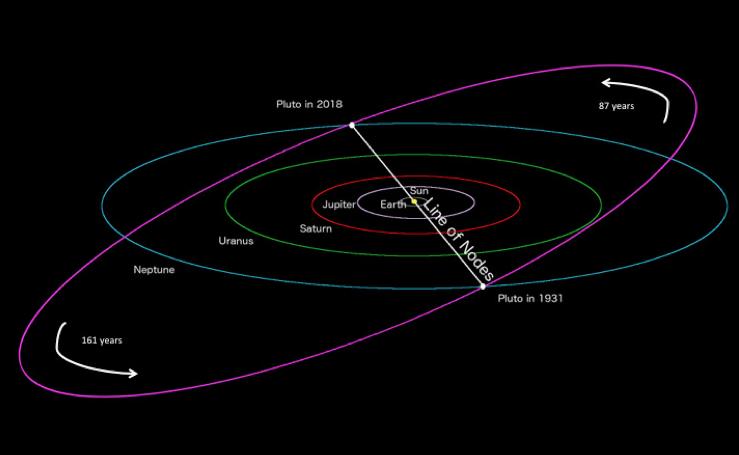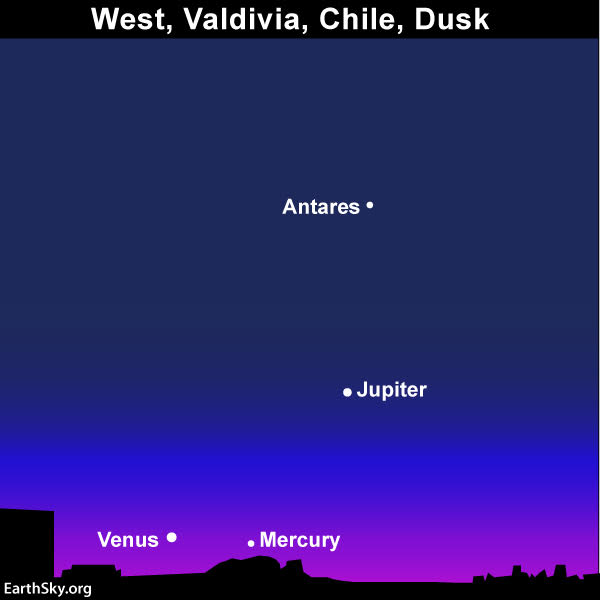These next four nights – October 14, 15, 16 and 17, 2018 – watch for the waxing moon to move from Saturn to Mars on the sky’s dome. Saturn and Mars are bright planets and therefore rather easy to see with the eye alone. On the night of October 14, you can tell which planet is Saturn and which is Mars, because the moon is much closer to Saturn on this date; by October 17 and 18, the moon will be the vicinity of the red planet Mars.
Saturn is the farthest world that you can easily see with the eye alone. Although it’s more than 10 astronomical units (10 times the sun-Earth distance) away from Earth right now, Saturn nonetheless shines as brilliantly as a 1st-magnitude star. Because this huge planet has the volume of more than 750 Earth’s, and its reflective rings are tilting nearly maximally toward Earth, this world is rather bright in Earth’s sky in 2018.
Contrasting the size of Saturn and its rings with our planet Earth via Hubble Heritage Team.
By the way, a modest backyard telescope is quite sufficient for viewing Saturn’s glorious rings. Try it tonight, as soon as darkness falls.
On October 15 and 16, the moon will swing by the dwarf planet Pluto before it meets up with Mars. Although Pluto lodges in the section of sky in between Saturn and Mars, don’t expect to see this extremely faint world, even with a telescope. Pluto, a far-distant inhabitant of the Kuiper Belt, is better than two thousand times fainter than the dimmest naked-eye star.
Pluto, which was reclassified as a dwarf planet by the International Astronomical Union (IAU) in 2006, reaches a big milestone in October 2018. Pluto crosses the ecliptic (Earth’s orbital plane) at its descending node on October 24, 2018.
Pluto: Preparing for the perfect alignment
Pluto last crossed the ecliptic at its ascending node some 87 years ago, in 1931, and won’t cross its ascending node again for another 161 years, in 2179. In fact, on January 11, 2019, when Pluto will lie opposite the sun in Earth’s sky, the sun-Earth-Pluto line will be so close to perfect that the sun will sit directly in front of our planet Earth from Pluto’s vantage point.

Image via Anne Verbiscer/ NASA New Horizons blog.
Pluto has gained some recognition with the advent of new terminology, such as the words plutino and plutoid. A plutino refers to any solar system object that orbits the sun twice for every three times that Neptune orbits the sun. A plutoid is any dwarf planet orbiting the sun beyond the orbit of Neptune, the eighth planet from the sun. According to the IAU’s definition, a dwarf planet must have enough mass to be spherical in shape.

In the Southern Hemisphere, and possibly the northern tropics, you have a decent chance of spotting the planets Mercury and Venus at evening dusk. The same can’t be said for Mercury and Venus at northerly latitudes, but Jupiter is still a possibility. Click here to find out when the sun, Mercury and Venus set in your sky.
Next month, in November 2018, the moon will actually occult (cover over) both Pluto and Mars. But you have to be at the just right place on Earth to witness either occultation.
In October 2018, the moon passes a touch north of Saturn, Pluto and Mars. In the case of Saturn or Mars, think photo opportunity.
These next several nights – October 14, 15, 16 and 17, 2018 – watch the waxing moon move from Saturn to Mars; and with the mind’s-eye, envision the invisible dwarf planet Pluto in between these two bright worlds.
from EarthSky https://ift.tt/2IWPaqG
These next four nights – October 14, 15, 16 and 17, 2018 – watch for the waxing moon to move from Saturn to Mars on the sky’s dome. Saturn and Mars are bright planets and therefore rather easy to see with the eye alone. On the night of October 14, you can tell which planet is Saturn and which is Mars, because the moon is much closer to Saturn on this date; by October 17 and 18, the moon will be the vicinity of the red planet Mars.
Saturn is the farthest world that you can easily see with the eye alone. Although it’s more than 10 astronomical units (10 times the sun-Earth distance) away from Earth right now, Saturn nonetheless shines as brilliantly as a 1st-magnitude star. Because this huge planet has the volume of more than 750 Earth’s, and its reflective rings are tilting nearly maximally toward Earth, this world is rather bright in Earth’s sky in 2018.
Contrasting the size of Saturn and its rings with our planet Earth via Hubble Heritage Team.
By the way, a modest backyard telescope is quite sufficient for viewing Saturn’s glorious rings. Try it tonight, as soon as darkness falls.
On October 15 and 16, the moon will swing by the dwarf planet Pluto before it meets up with Mars. Although Pluto lodges in the section of sky in between Saturn and Mars, don’t expect to see this extremely faint world, even with a telescope. Pluto, a far-distant inhabitant of the Kuiper Belt, is better than two thousand times fainter than the dimmest naked-eye star.
Pluto, which was reclassified as a dwarf planet by the International Astronomical Union (IAU) in 2006, reaches a big milestone in October 2018. Pluto crosses the ecliptic (Earth’s orbital plane) at its descending node on October 24, 2018.
Pluto: Preparing for the perfect alignment
Pluto last crossed the ecliptic at its ascending node some 87 years ago, in 1931, and won’t cross its ascending node again for another 161 years, in 2179. In fact, on January 11, 2019, when Pluto will lie opposite the sun in Earth’s sky, the sun-Earth-Pluto line will be so close to perfect that the sun will sit directly in front of our planet Earth from Pluto’s vantage point.

Image via Anne Verbiscer/ NASA New Horizons blog.
Pluto has gained some recognition with the advent of new terminology, such as the words plutino and plutoid. A plutino refers to any solar system object that orbits the sun twice for every three times that Neptune orbits the sun. A plutoid is any dwarf planet orbiting the sun beyond the orbit of Neptune, the eighth planet from the sun. According to the IAU’s definition, a dwarf planet must have enough mass to be spherical in shape.

In the Southern Hemisphere, and possibly the northern tropics, you have a decent chance of spotting the planets Mercury and Venus at evening dusk. The same can’t be said for Mercury and Venus at northerly latitudes, but Jupiter is still a possibility. Click here to find out when the sun, Mercury and Venus set in your sky.
Next month, in November 2018, the moon will actually occult (cover over) both Pluto and Mars. But you have to be at the just right place on Earth to witness either occultation.
In October 2018, the moon passes a touch north of Saturn, Pluto and Mars. In the case of Saturn or Mars, think photo opportunity.
These next several nights – October 14, 15, 16 and 17, 2018 – watch the waxing moon move from Saturn to Mars; and with the mind’s-eye, envision the invisible dwarf planet Pluto in between these two bright worlds.
from EarthSky https://ift.tt/2IWPaqG

Aucun commentaire:
Enregistrer un commentaire